Bijzondere werken van Karel Appel zoals ik ze eigenlijk nog niet eerder zag. Een eye-opener dus.
Encounter in Spring and what follows, an exhibition of work by Karel Appel (1921–2006), centring around a selection of paintings spanning from 1958 until 2006.
A founding figure of the avant-garde group CoBrA (1948–1951), Appel began his career in the aftermath of the Second World War. Over the course of six decades, the artist experimented widely, drawing on sources as diverse as folk art, outsider art and Jazz’s spirit of improvisation, and working across painting, sculpture, drawing, and stage design. Distinguishable for his astonishing capacity to innovate, Appel never settled in a signature style, media or subject. Alternating between abstraction and figuration, he adopted a material-oriented approach in his practice and promoted a genuine form of expression.
The exhibition’s starting point is the monumental and mesmeric painting Rencontre au printemps (Encounter in Spring), which was commissioned in 1958 for the inauguration of the UNESCO headquarters in Paris. To mark the occasion, UNESCO invited Appel – among luminaries including Jean Arp, Alexander Calder, Isamu Noguchi, Roberto Matta, Joan Miró, Henry Moore, and Pablo Picasso – to make a contribution. Appel painted the ambitious work, not on-site or in his Paris studio, which couldn’t accommodate its size, but in Sam Francis’ studio in Villejuif. He had, by this point, just returned from his first trip to New York for his second exhibition at Martha Jackson Gallery and was profoundly marked by his encounter with the painters of the New York School. As such, Encounter in Spring constitutes Appel’s first painting on such a momentous scale and remains one of the highlights of the UNESCO art collection.
Appel executed a sister painting, Encounter of Worlds, of the same size and year, which is in the collection of the Neue Nationalgalerie in Berlin. Key works in his oeuvre, the two paintings introduce a pictorial language that comes very close to abstraction and is animated by the same spirit of Action Painting. While they might seem a far cry from CoBrA, founded only ten years earlier in Paris, both imply, at their essence, its rallying creed for freedom and spontaneity.
As its title suggests, the sweeping abstract gestures of Encounter in Spring seem to unfurl beneath the viewer’s gaze into an abundance of forms found in nature and landscapes. Treading the threshold between impression and expression, Appel consistently associated real-world experience with what is visible on the canvas and what to a cursory glimpse might appear abstract. This liminal quality binds the works that comprise this exhibition. Viewed in chronological sequence, they reveal the overarching influence of Appel’s discovery of American painting on his first visit to the continent in 1957, and beyond. This is strikingly evident in the richly textured surface of Shattered World, 1960, with its thick impasto paint that appears to have been applied directly from the tube to the left side of the canvas, as much as the primitively rendered face which emerges from the crude brushstrokes and vibrant palette of Visage-Paysage no.4, 1977.
In the Trees series from 1979, Appel’s formerly expressive free lines and solid areas of monochrome brushwork are here substituted for simplified, nearly analytical structures made from a sequence of short parallel brush marks which converge on ascending, vertical formats. The artist had previously come cross enlarged reproductions of details from paintings by Vincent van Gogh – a discovery which paved the way for this new sense of expression, merging discipline with spontaneity. In the late ’90s, works including Up to the Sky no.3, 1998, and Birth of a Landscape, 1999, present densely animated, near-impressionist landscapes, which pulsate with thick swathes of paint. By the 2000s, Appel’s idiom had evolved once more into looser compositions of colour and form: works such as Nimble Acrobat, 2000, and Thought’s Boomerang, 2000, appear light and airy, with large swathes of raw canvas still visible, while in Evening Forest, 2003, real wood branches are embedded on the surface of the work. Brimming with creative innovation, this exhibition encapsulates the work of an artist whose imaginative and experimental approach to the painterly medium never ceased.

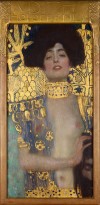
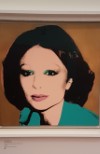
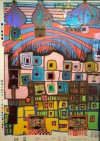

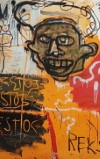
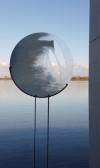
 Het MOCTA is een bijzonder klein museum in de oude dierentuin van Emmen. Het Museum of Contemporary Tibetan Art is opgezet rondom, met name, Tashi Norbu’s kunstwerken, aangevuld met een aantal andere hedendaagse kunstenaars van Tibetaanse afkomst. Het klinkt oneerbieding, maar ik vind de kunst een hoog kitschgehalte hebben. Het is leuk om een half uurtje door te brengen, als je toch in de buurt bent.
Het MOCTA is een bijzonder klein museum in de oude dierentuin van Emmen. Het Museum of Contemporary Tibetan Art is opgezet rondom, met name, Tashi Norbu’s kunstwerken, aangevuld met een aantal andere hedendaagse kunstenaars van Tibetaanse afkomst. Het klinkt oneerbieding, maar ik vind de kunst een hoog kitschgehalte hebben. Het is leuk om een half uurtje door te brengen, als je toch in de buurt bent.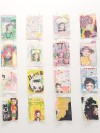 Omdat ik dacht werken op papier van Tamara Muller aan te treffen, zocht ik de expo Connection op in Galerie Bart op de Elandsgracht. In de expo zie je werken van meer gevestigde namen én werken van de jonge kunstenaars die door hen gevraagd zijn te exposeren. En zo zag ik werken van Emily Kümmeler, een heel palet aan mooie tekeningen en Wim Jacobs, werken van artiesten die ik voorheen nog niet kende. En de video van Tamara Muller? Die was zeker ook indrukwekkend.
Omdat ik dacht werken op papier van Tamara Muller aan te treffen, zocht ik de expo Connection op in Galerie Bart op de Elandsgracht. In de expo zie je werken van meer gevestigde namen én werken van de jonge kunstenaars die door hen gevraagd zijn te exposeren. En zo zag ik werken van Emily Kümmeler, een heel palet aan mooie tekeningen en Wim Jacobs, werken van artiesten die ik voorheen nog niet kende. En de video van Tamara Muller? Die was zeker ook indrukwekkend.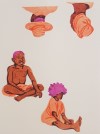 Wow, beter kan ik het niet uitdrukken! Ik vind de illustraties en tekeningen van Hedy Tjin even indrukwekkend als haar street art in de Bijlmer en de Zeeburgerdijk. En om ze dan in het echt te zien, au naturel, zoals ze ze zelf op papier heeft gezet, dan is enorm leuk. In het kleine Meterhuis springen de kleuren in alle vrolijkheid van het papier. Als je dan de onderwerpen bekijkt, dan blijken er zware thematieken onder te liggen. Haar tekeningen voor Op de rug van Bigi Kayman bijvoorbeeld, gaan over slavernij en de ontsnapping van tot slaaf gemaakten. Een erg mooie expo, die ik niet had willen missen.
Wow, beter kan ik het niet uitdrukken! Ik vind de illustraties en tekeningen van Hedy Tjin even indrukwekkend als haar street art in de Bijlmer en de Zeeburgerdijk. En om ze dan in het echt te zien, au naturel, zoals ze ze zelf op papier heeft gezet, dan is enorm leuk. In het kleine Meterhuis springen de kleuren in alle vrolijkheid van het papier. Als je dan de onderwerpen bekijkt, dan blijken er zware thematieken onder te liggen. Haar tekeningen voor Op de rug van Bigi Kayman bijvoorbeeld, gaan over slavernij en de ontsnapping van tot slaaf gemaakten. Een erg mooie expo, die ik niet had willen missen.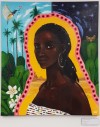 Een expositie met alleen werken van vrouwen, waarbij in de naam van de expo Sexy en Smart zijn doorgehaald en Creative dus blijft staan. Ik kwam al een keer voor de dichte deur bij Artotel, maar nu heb ik toch deze expo mee weten te nemen. En hoewel klein, is het zeker fijn. Met werken van Nouch, de enige die ik al kende en in de buitenlucht altijd geweldig vind, en werken van verder nog Page33, Kristel Steenbergen (zie plaatje), Jas Charanjiva en Minivila onder andere. De moeite waard als je in de buurt bent.
Een expositie met alleen werken van vrouwen, waarbij in de naam van de expo Sexy en Smart zijn doorgehaald en Creative dus blijft staan. Ik kwam al een keer voor de dichte deur bij Artotel, maar nu heb ik toch deze expo mee weten te nemen. En hoewel klein, is het zeker fijn. Met werken van Nouch, de enige die ik al kende en in de buitenlucht altijd geweldig vind, en werken van verder nog Page33, Kristel Steenbergen (zie plaatje), Jas Charanjiva en Minivila onder andere. De moeite waard als je in de buurt bent. De Koninklijke prijs voor de vrije schilderkunst wordt tentoongesteld in het Koninklijk Paleis, a.k.a. het Paleis op de Dam. Voor het eerst in alle decennia dat ik in Amsterdam kom, ben ik dus in het Koninklijk Paleis. De expositie is indrukwekkend, met een flink aantal werken van zwarte artiesten of artiesten met een niet-westerse achtergrond. En dat geeft niet alleen extra dimensie, maar simpelweg ook betere representatie. Ik kom met name voor het werk Iriée Zamblé maar de andere werken zijn zeker ook de moeite waard.
De Koninklijke prijs voor de vrije schilderkunst wordt tentoongesteld in het Koninklijk Paleis, a.k.a. het Paleis op de Dam. Voor het eerst in alle decennia dat ik in Amsterdam kom, ben ik dus in het Koninklijk Paleis. De expositie is indrukwekkend, met een flink aantal werken van zwarte artiesten of artiesten met een niet-westerse achtergrond. En dat geeft niet alleen extra dimensie, maar simpelweg ook betere representatie. Ik kom met name voor het werk Iriée Zamblé maar de andere werken zijn zeker ook de moeite waard.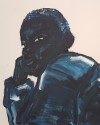 Het is een hele trek naar Factor IJ, op IJburg maar de expositie van Iriée Zamblé in het echt zien, daarvoor legde ik de afstand graag af. Er zijn een aantal werken die nog niet afgerond zijn, en dan ook nog de kunstenaar zelf die ter plekke aan het werk was. Erg leuk!
Het is een hele trek naar Factor IJ, op IJburg maar de expositie van Iriée Zamblé in het echt zien, daarvoor legde ik de afstand graag af. Er zijn een aantal werken die nog niet afgerond zijn, en dan ook nog de kunstenaar zelf die ter plekke aan het werk was. Erg leuk!